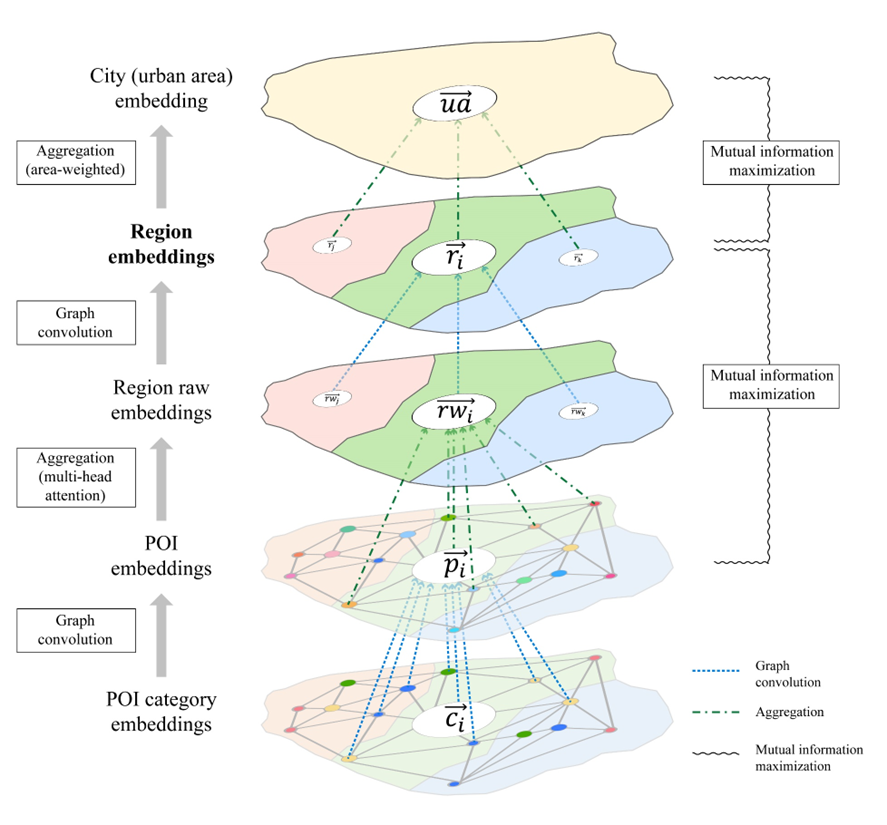This project is linked to a paper published in ISPRS Journal of Photogrammetry and Remote Sensing: Learning urban region representations with POIs and hierarchical graph infomax
.
In this study, we propose the hierarchical graph infomax (HGI) approach for learning urban region representations (vector embeddings) with points-of-interest (POIs) in a fully unsupervised manner, which can be used in various downstream tasks.

With this repository, you can
- learn the region representations using the pre-constructed sub-sampled dataset in Shenzhen, China;
- use the learned region embeddings for downstream tasks.
- Python 3.8.13
- PyTorch 1.12.1
- Pytorch_geometric 2.1.0
- Scikit-learn 1.1.2
- Tdqm 4.61.4
- Pytorch_warmup 0.1.0
There are two main scripts in this repository: train.py and evaluation.py.
train.py is used to learn the region representations. You can specify the dataset by setting the --city argument. For example, to learn the region representations for Shenzhen or xiamen, you can run
python train.py --city shenzhen
The learned region representations will be saved in the ./Emb folder.
The arguments that can be specified in train.py are as follows:
--city: the city name, e.g., "shenzhen".- We provide a sample pre-processed dataset (subset of the dataset) in Shenzhen, and you could download the data
shenzhen_data.pkland put it under the folderData. After that, you can runpython train.py --city shenzhento learn the region representations for Shenzhen.
- We provide a sample pre-processed dataset (subset of the dataset) in Shenzhen, and you could download the data
--dim: the dimension of the learned region representations.--alpha: the hyperparameter to ba balance mutual information.--attention_head: number of attention heads in the aggregation function.--lr: the learning rate.--max_norm: the maximum norm of the gradient.--gamma: gamma in learning rate scheduler.--warmup_period: the warmup period, i.e., how many epochs for linear learning rate warmup.--epoch: the number of epochs.--device: the device to use, which can becpuorcudaorcuda:{}.--save_name: the name of the saved region representations.'
In case you would like to construct your own dataset to learn region representations for other study areas, you need to construct a Data object in the ./Data folder. The Data object should contain the following attributes:
x: POI initial features, which can be POI category embeddings (can even be one-hot vectors) or POI embeddings learned by other methods.edge_index: the POI graph structure, which is a tensor of shape (2, E), where E is the number of edges.edge_weight: the edge weights.region_id: the region id of each POI.region_area: the area proportion of each region in its city.coarse_region_similarity: the coarse similarity of each region with all other regions. This is a (N, N) matrix, where N is the number of regions.region_adjacency: the adjacency matrix of regions.
evaluation.py is used to evaluate the learned region representations. Currently it supports two study areas:
xiamen: Xiamen Island, Chinashenzhen: Shenzhen, China and three downstream tasks:uf: urban function inference (this repo contains mocked ground truth data, the real ground truth data can be requested from here)pd: population density estimationhp: housing price estimation
For example, you could run
python evaluation.py --city xiamen --task pd
to evaluate the learned region representations for Xiamen Island on population density estimation. The results will be printed in console.

The learned region representations for Xiamen Island and Shenzhen are available in the ./Emb folder. You can load them by torch.load().
Some codes for the pooling from POIs to regions are borrowed from Set Transformer's GitHub repository.
If you use the code in this project, please cite the paper the ISPRS Journal.
@article{huang2023hgi,
title={Learning urban region representations with POIs and hierarchical graph infomax},
author={Huang, Weiming and Zhang, Daokun and Mai, Gengchen and Guo, Xu and Cui, Lizhen},
journal={ISPRS Journal of Photogrammetry and Remote Sensing},
volume={196},
pages={134--145},
year={2023}
}
Weiming Huang (Nanyang Technological University)
Email: weiming.huang@ntu.edu.sg